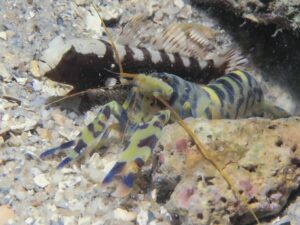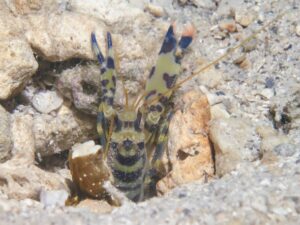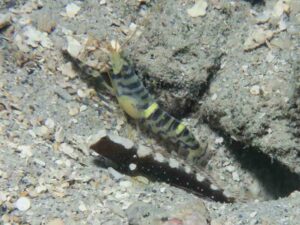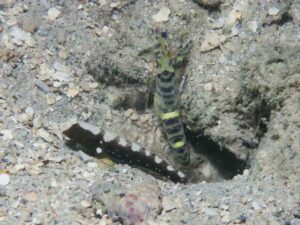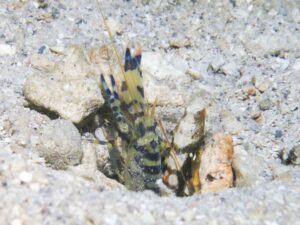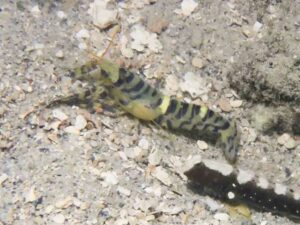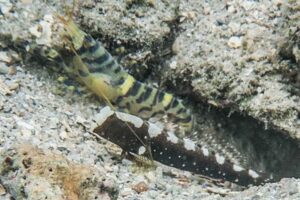Blue and Yellow Banded Snapping Shrimp
Alpheus cf djiboutensis
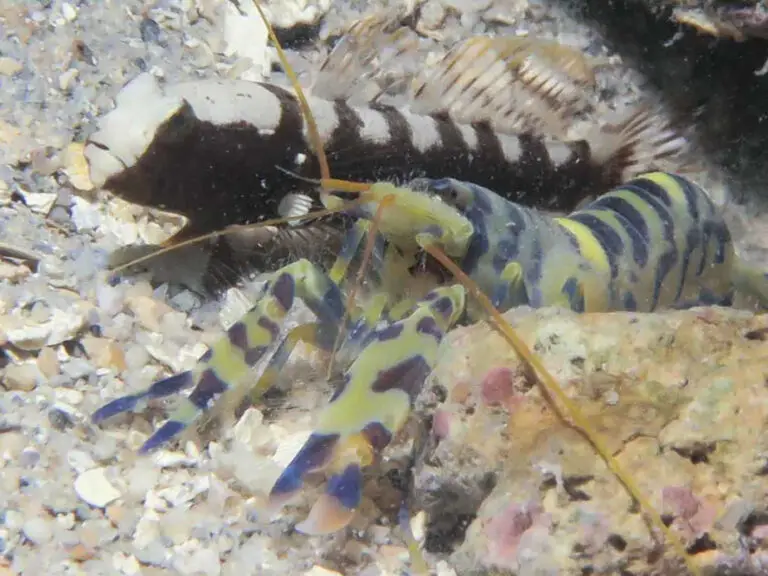
Blue and Yellow Banded Snapping Shrimp
Alpheus cf djiboutensis
undescribed
Description
A striking-looking shrimp boldly marked in blue and yellow bands. In our experience restricted to very shallow water.
The carapace is yellow with five dark blue dorsal bands. The third and fifth bands are narrower and extend to the lateral aspect of the carapace.
The abdomen is pale yellow with a blue transverse band on each segment. There is a bold yellow band on the first and fourth segments.
The rostrum is yellow with orange appendages. The antennae and antennules are orange.
The pincers are yellow with three broken transverse blue bars, pollex and dactyl dark blue with orange tips.
The walking legs are blue with yellow joints.
Identifying Features
This boldly marked and brightly coloured shrimp is not easily confused with other partner shrimps.
Similar Shrimps
The Banded Shrimp is similar but there are colour and habitat differences.
Nomenclature
We are not entirely happy about attributing this shrimp to the Alpheus djiboutensis. complex as we see several ecological and behavioural differences. However, the appearance of this shrimp is close to published images of Alpheus djiboutensis.
The status of Alpheus djeddensis – djiboutensis is questionable, Anker (2010) Miya in Bruce (1994).
Debelius (2001) Crustacea p152 has images of a similar-looking shrimp and gives the name Alpheus djiboutensis. Length up to 4 cm. Distribution East Africa to Australia, Solomon Islands. Widespread in Indo-Pacific.
Ecology
Habitat
We have only recorded this shrimp so far from the Low Isles, Queensland, where they live on coral rubble and close to mangrove roots in very shallow water in areas that are exposed from mid to low tide.
In the area we have seen them they are only associated with the Saddled Shrimpgoby, Cryptocentrus leucostictus. The similar-looking Maude’s Shrimpgoby, Cryptocentrus maudae which shares the same habitat appears to partner only with the Pale Marbled Shrimp.
Preferred substrate
Coral rubble and sand.
Depth range
0 to 3 metres
Proximity to reef
On top of the reef flat.
NATURAL HISTORY
In Queensland, this shrimp is restricted to a difficult intertidal habitat where their burrows are exposed at low tide. They form an association with only one species of goby which is equally restricted in its distribution.
They appear to dig a vertical burrow perhaps so that they can be deep enough to extend below the water when exposed at low tide. The burrow entrance may be up to 1 metre above the water level at spring-low tides.
The burrows are often found amongst the roots of the Red Mangrove, Rhizophora stylosa.
Distribution
Published distribution: Alpheus djiboutensis is described as ‘widespread Indo-Pacific and Red Sea’ Kuiter and Debelius (2009)
Our records: Australia; Low Isles.
Associated Shrimpgoby species
Associated Shrimpgobies (one species)
Usual association:
Cryptocentrus leucostictus, Saddled Shrimpgoby

